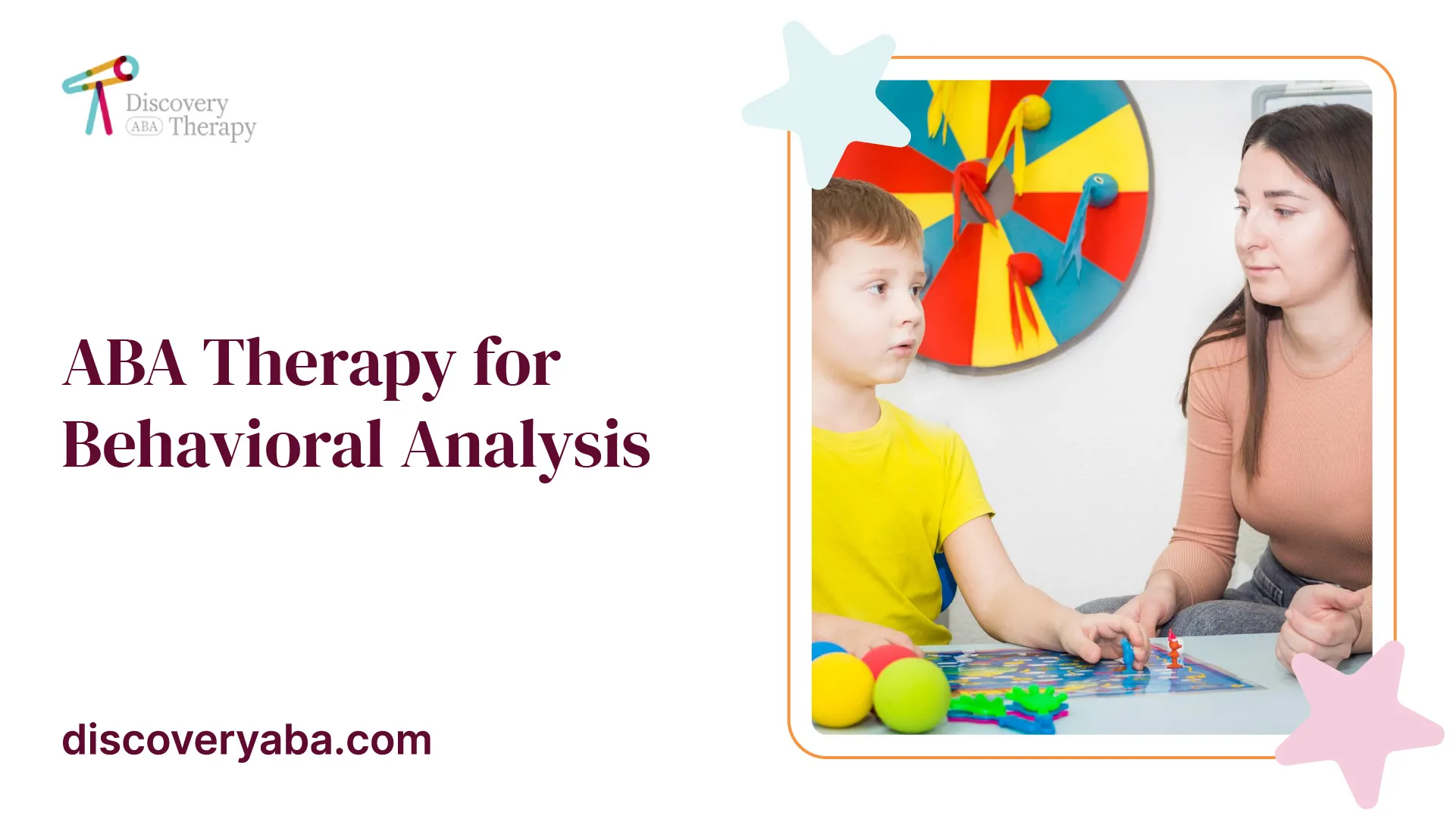ABA Therapy for Behavioral Analysis
Explore ABA therapy for behavioral analysis, its techniques, benefits, and impact on children with ASD.

Understanding ABA Therapy
Overview of ABA Therapy
Applied Behavior Analysis (ABA) is a scientific approach centered on the principles of behavior change and how behaviors are influenced by environmental factors. It emphasizes learning processes and aims to establish and enhance socially significant behaviors, such as academic achievement, social interaction, communication, and daily living skills. The ultimate goal is to improve individual independence and overall quality of life for those receiving the therapy. A variety of professionals, including parents, teachers, and psychologists, utilize ABA strategies to manage behaviors, teach new skills, and achieve better outcomes across different settings [1].
The techniques within ABA are particularly beneficial for special populations, notably individuals with Autism Spectrum Disorder (ASD). ABA therapy is recognized for its effectiveness in addressing a broad spectrum of symptoms associated with ASD, including difficulties in socialization, communication, and expressive language. Many children can begin ABA therapy before the age of six, as early intervention can significantly impact their developmental trajectory [2].

Importance of ABA for ASD
In the context of ASD, ABA therapy plays a crucial role in fostering essential life skills. By focusing on the development of skills like fine motor dexterity and personal hygiene, ABA helps children navigate daily tasks that enhance their autonomy. Moreover, the therapy emphasizes social skills and emotional regulation alongside communication abilities, which are vital for effective interaction with peers and caregivers.
Through positive reinforcement strategies, ABA encourages children to use words and better comprehend language. Techniques such as offering rewards and praise when children attempt to communicate foster an environment conducive to learning. Incorporating elements like pictures or games can also make the learning experience enjoyable and engaging for children with ASD. Such methods contribute to significant improvements in communication capabilities and lead to positive long-term outcomes in social engagement and emotional wellbeing [2].
For more information on behavior modification techniques, you can explore our section on aba therapy and behavior modification.
Techniques in ABA Therapy
ABA therapy employs various techniques to encourage positive behavior changes and enhance skills among individuals with Autism Spectrum Disorder (ASD). This section will discuss three key techniques: Positive Reinforcement, Discrete Trial Training, and Antecedent-based Interventions.
Positive Reinforcement
Positive reinforcement is a fundamental technique in ABA therapy that involves providing immediate rewards or praise following desired behaviors. This method encourages the repetition of these behaviors. For example, if a child asks for a toy instead of grabbing it, providing the toy as a reward reinforces the appropriate request behavior [3].
The importance of positive reinforcement in encouraging favorable behaviors can be illustrated as follows:
Behavior EncouragedPositive ReinforcementAsking politely for a toyReceiving the toyCompleting a homework assignmentGetting praise or a rewardFollowing directionsEarning a preferred activity
Discrete Trial Training
Discrete Trial Training (DTT) is another vital strategy in ABA therapy. In DTT, skills are broken down into small, manageable components. After teaching each element, positive reinforcement is administered for correct responses. For instance, when teaching emotions, a therapist may break down the concept of happiness and provide feedback when the child correctly identifies it.
DTT is performed in a structured manner where each trial includes a specific demand, prompt, and reinforcement. The process can be summarized in the following table:
ComponentDescriptionDemandThe instruction given to the child (e.g., "Point to happy.")PromptAssistance provided to help the child respond correctlyReinforcementPraise or rewards for correct responses
Antecedent-based Interventions
Antecedent-based Interventions (ABI) focus on modifying the environment to reduce triggers that lead to unwanted behaviors. By altering the antecedents—what happens before a behavior—therapists aim to enhance the child's focus and learning outcomes.
For example, if a child becomes distracted by noise during therapy, the intervention might involve moving to a quieter location or using noise-canceling headphones. The table below outlines common antecedent strategies:
Antecedent StrategyPurposeAdjusting the learning environmentReduces distractionsProviding clear visual schedulesEnhances understanding of expectationsPre-teaching skillsPrepares the child for upcoming activities
Understanding these fundamental techniques is essential for parents and caregivers involved in ABA therapy. They help in applying appropriate interventions and strategies to support individuals with ASD effectively. For further reading, check out our articles on aba therapy and behavior modification and aba therapy and autism interventions.
Impact of ABA Therapy
Behavior Modification
ABA therapy is designed to address behaviors in individuals with Autism Spectrum Disorder (ASD). The therapy utilizes systematic techniques that focus on behavior modification, which can lead to significant changes in how individuals interact and respond to their environment. Through targeted interventions, children learn new skills while reducing problematic behaviors.
One of the key aspects of behavior modification in ABA therapy is the use of positive reinforcement. This strategy involves rewarding desired behaviors, making them more likely to be repeated in the future. Under ABA therapy protocols, consistent reinforcement reduces maladaptive behaviors, leading to improved overall behavior standards.
The following table summarizes effectiveness data on behavior modification techniques used in ABA therapy:
Behavior Modification Strategy% ImprovementPositive Reinforcement80%Discrete Trial Training75%Antecedent-based Interventions70%
For further information on how this therapy works, see our article on aba therapy and behavior modification.
Social and Communication Skills Development
ABA therapy significantly enhances social and communication skills among children with autism. The therapy employs strategies such as natural environment training, direct instruction, and group learning to support social interactions [2]. It encourages children to articulate thoughts, recognize social cues, and engage in meaningful conversations.
Moreover, ABA focuses on developing essential life skills. Children learn not just to communicate but also to improve their expressive language and understand nuances in conversations. The structured nature of ABA facilitates the acquisition of skills like personal hygiene and social etiquette, leading to better social integration and independence.
Skills Developed% of Participants ImprovingSocial Skills85%Communication Skills70%Life Skills75%
The successful implementation of these focused interventions allows for more natural interactions, which in turn promotes self-confidence and emotional regulation. To learn more about the broader applications of ABA in enhancing communication, you can visit aba therapy and autism interventions.
Through ABA therapy, many find that children not only excel academically but also cultivate social relationships, enriching their everyday experiences.
ABA Therapy Benefits
ABA therapy offers a range of benefits for individuals with autism spectrum disorder (ASD). Among the most significant advantages are the enhancement of life skills and the development of emotional regulation techniques.
Life Skills Enhancement
One of the primary goals of ABA therapy is to foster essential life skills in children with autism. These skills include fine motor dexterity, personal hygiene, grooming, social interaction, communication, reading, and academics. By targeting these areas, ABA therapy assists children in becoming more independent and functional in their daily lives.
Key Life Skills Developed in ABA Therapy
Skill AreaSkills DevelopedFine Motor SkillsWriting, using utensils, buttoning clothesPersonal HygieneBathing, brushing teeth, dressing appropriatelySocial SkillsTaking turns, sharing, initiating conversationsCommunicationUsing words, understanding languageAcademic SkillsReading, math concepts
ABA therapists employ a variety of techniques, including positive reinforcement, to encourage the acquisition of these skills. By creating rewarding learning environments, children often respond positively to instruction, leading to improved skill sets over time. For more about how positive reinforcement is used, see our article on aba therapy and positive reinforcement.
Emotional Regulation Techniques
Emotion regulation is another vital aspect of ABA therapy. Children with autism can face challenges in expressing and managing their emotions effectively. ABA therapy provides them with the tools to communicate these feelings and cope with negative emotions constructively.
Therapists utilize natural environment training methods and play therapy to help children express anger, frustration, and other negative emotions appropriately. This approach empowers children to understand their emotional responses and equips them with coping strategies that can be applied in real-world situations.
Benefits of Emotional Regulation Techniques
TechniqueBenefitNatural Environment TrainingHelps children practice skills in everyday settingsPlay TherapyEncourages expression of feelings in a fun mannerCoping StrategiesTeaches children how to manage emotions effectively
As a result, children attending ABA therapy can learn to manage aggression and self-injury tendencies, providing them with a compilation of practical methods and caring support from their therapists [4].
For those interested in exploring the various interventions and assessment methods used in ABA, additional information can be found in our articles on aba therapy and autism interventions and aba therapy and behavioral assessment.
Implementation of ABA Therapy
The implementation of ABA therapy involves structured sessions focused on specific goals tailored to the needs of the child with autism spectrum disorder (ASD). Active participation from caregivers is also essential for the success of the therapy.
Therapy Sessions and Goals
ABA therapy generally consists of a recommended range of 10 to 40 hours of dedicated therapy each week for children with autism. In addition to these sessions, caregivers typically engage in 30 minutes to one hour of collaboration and family training each week. This combination continues until all set goals are achieved, although many individuals benefit from ongoing support.
The goals set during therapy are evidence-based and focus on meaningful behavior change. Behavior analysts break down larger objectives into smaller, achievable steps, allowing children to navigate skill development more effectively. Common targeted areas may include:
Target AreasSpecific GoalsDaily Living SkillsToileting, hygiene, feeding, dressingExpressive CommunicationUsing complex language, improving conversations, social greetingsSocial SkillsAsking for help, requesting items, saying please and thank you
These goals are tailored to the individual child and are designed to enhance overall self-sufficiency and independence. Progress can vary based on factors such as the number of therapy hours, individual abilities, and parental involvement [6].
Involvement of Caregivers
Caregiver involvement is a critical component of ABA therapy. Training and collaboration with family members help ensure that the strategies learned during therapy are reinforced in everyday life. This collaboration can significantly impact the generalization of skills in different settings, promoting behavioral changes outside of therapy sessions.
Engaging caregivers in the process fosters a better understanding of the techniques used within ABA therapy, which empowers them to effectively support their child's development. Consistent reinforcement of learned skills at home can enhance a child’s ability to transition those skills into their daily life.
Parents and caregivers are encouraged to actively participate in therapy sessions, share observations, and communicate with behavior analysts. This partnership not only enhances the child’s progress but also creates a supportive environment for skill development. For more on behavior modification, review our resource on ABA therapy and behavior modification.
Controversies Surrounding ABA
ABA therapy has faced scrutiny and discussion regarding its effectiveness and implementation methods throughout its history. This section delves into the historical criticisms of ABA and highlights modern adaptations and perspectives that have emerged in response.
Historical Criticisms
Initially, applied behavior analysis (ABA) utilized a variety of techniques, including punishments alongside rewards to manage behaviors. This approach raised ethical concerns among parents and advocates, particularly regarding the implications for children's emotional and psychological well-being. Critics argue that this early focus on punishment and behavior elimination, rather than skill development, was detrimental. Parents and autistic self-advocates express reservations about the therapy's history of making autistic children conform to neurotypical standards.
As awareness of these concerns grew, many practitioners evolved their techniques. While modern ABA no longer employs punitive measures, critics suggest that the approach can still be overly repetitive and may fail to engage children fully. This has led to ongoing discussions about the effectiveness of traditional methods versus more contemporary, playful approaches to therapy. Advocates for change emphasize the need for therapy structures that not only reduce unwanted behaviors but also foster new skills [7].
Modern Adaptations and Perspectives
In response to historical critiques, many practitioners have adopted more flexible and engaging ABA methodologies. Emphasizing play-based interventions, these modern adaptations aim to make learning enjoyable and tailored to individual needs. Practitioners increasingly recognize the importance of focusing on skill development rather than solely on behavior elimination. This involves teaching children the behaviors they should exhibit instead of primarily concentrating on the undesirable behaviors to be extinguished [7].
Despite these adaptations, some self-advocates and critics contend that the underlying goal of ABA can still reflect a push towards conformity with neurotypical norms. They advocate for alternative therapies, such as speech and language therapy, that prioritize communication, individuality, and the unique needs of each child. The evolving nature of ABA techniques aims to balance the need for behavior modification with a more holistic approach that values each child's inherent neurodiversity [7].
ABA continues to be a significant component in the broader field of autism interventions, necessitating ongoing dialogue to ensure it meets the diverse needs of children with autism. To explore more on therapy techniques, visit our pages on aba therapy and behavioral assessment and aba therapy and autism interventions.
References
[2]:
[3]:
[4]:
[5]:
[6]:
[7]:
Does Your Child Have An Autism Diagnosis?
Learn More About How ABA Therapy Can Help
Find More Articles
Contact us
North Carolina, Nevada, Utah, Virginia
New Hampshire, Maine
Arizona, Colorado, Georgia, New Mexico, Oklahoma, Texas
.avif)




































































































